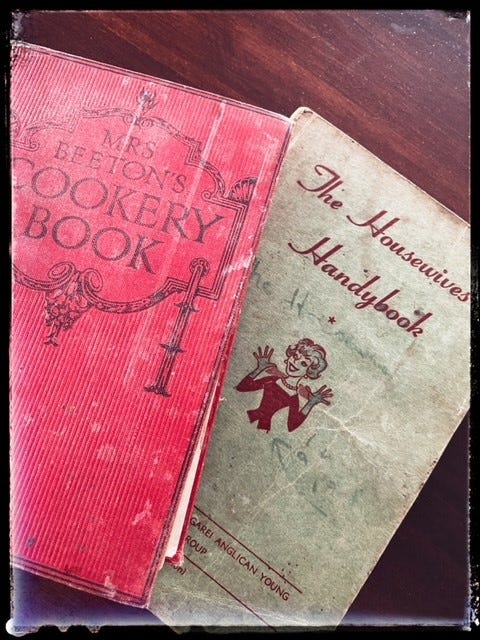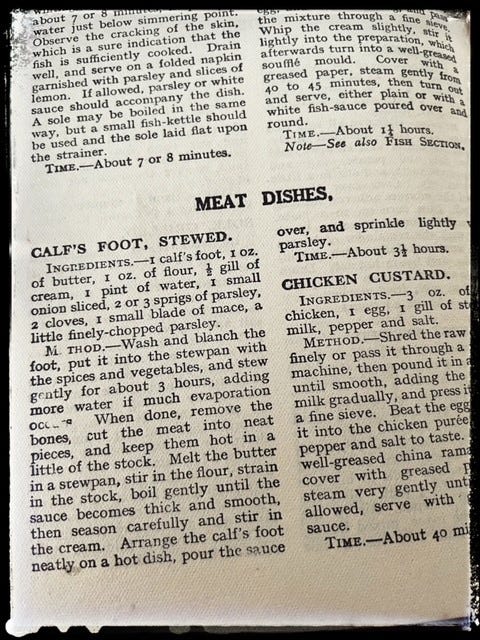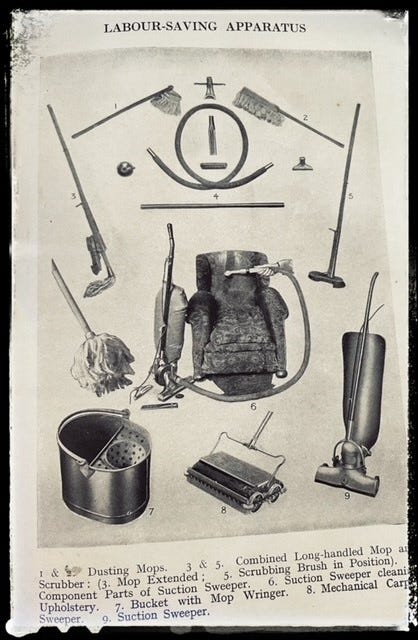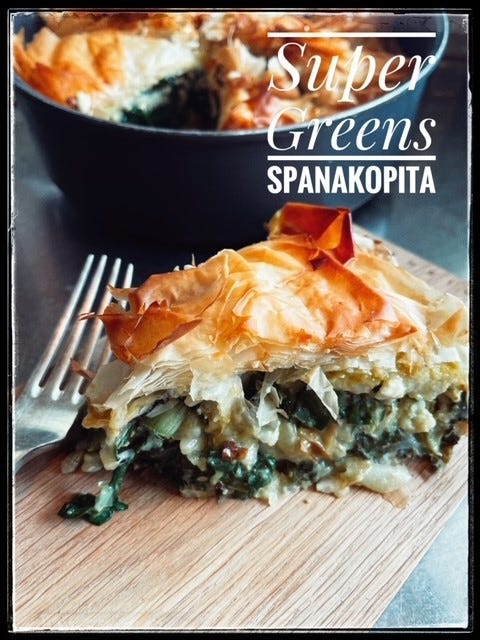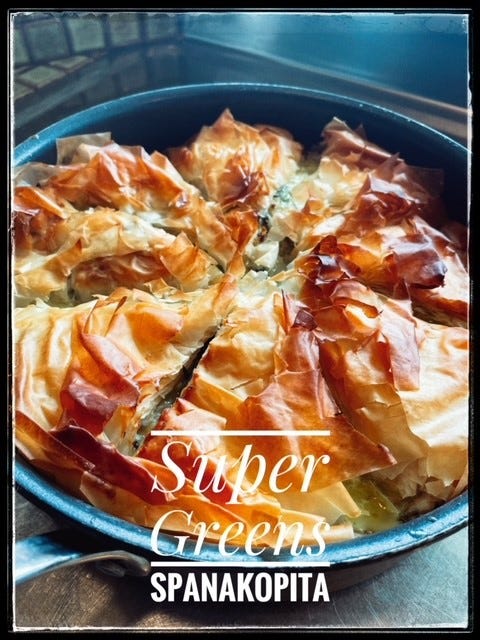Pondering Pigs Ears With Mrs Beeton.
And I throw a Spanakopita in the works!
I’ve been flat out the last few weeks. The vege garden is heaving with ripe produce and now’s the time to pick and preserve as much as we can, make hay while the sun shines and all that.
In this day and age, preserving food seems incredibly antiquated, very twee and it’s had me hauling out my oldest books and rifling through looking for techniques used in days gone by to keep a taste of summer on the shelves long after the sun is gone.
There are two books on my bookshelf that are pulled out from time to time to find a recipe or an idea to help in the kitchen when more modern publications fall short. Mrs Beetons Cookery Book is one and the other; The Housewives Handybook - compiled by the Whangarei Anglican Young Wives Group. These two are akin to time travel if you ask me. They contain handwritten notes from long deceased loved ones and ingredients that might as well be ‘eye of newt and toe of frog’ they are so obscure. What has me searching in the pages for answers is that the advice is tried and true and so simple in it’s presentation that it’s often overlooked.
I remember my sister and I from time to time would grab the books and open them up just for a laugh. We’d joke about the ancient idea of a woman needing an entire chapter dedicated to making pretty floral arrangements for her home, ponder the availability of the plants in the poisonous section (good for nasty boys at school!) and both voice our repugnance at the lengthy recipes that included offal of one kind or another.
Given that these books read as though they are from the dark ages I’m fascinated that they are reasonably recent; Mrs Beetons published in 1935 and The Handy Housewives 1964. Both of them are targeted firmly at women and women only and both have a large portion of the book dedicated to housekeeping as well as recipes.
Mrs Beeton begins her housekeeping chapter in sympathy with the modern housewife, the shortage of labour and higher wages forcing many to let go of the three or four ‘servants’ in their employ and to soldier on with only a charwoman; lord help us ladies! Luckily for the harassed housewife modern technology was on the way in the form of electrically operated crockery washers, electric ironing machines, mechanical carpet sweepers and wringer washing machines. Just imagine all that time and expense we can save!
I get the sense that if Mrs B liked a clean house she liked a frugal one even more. She had a ‘trotter to snout’ kind of approach to cooking; the kind that would have the vegans reaching for their smelling salts in a swoon at a mere glance of the recipe. Now don’t get me wrong, I’ve always been a fan of using as much as you can, I’ve also always ascertained that anything when crumbed and fried tastes good but even I would take some coaxing to bite into a “fried pigs ear with parsley and anchovy sauce”. Another thrifty recipe in the pork section is a little gem called ‘Stewed Pigs Pettitoes’, the last word is a mix of ‘pettite’ meaning small in French and ‘toes’ meaning; well toes. Little pigs toes. Here’s hoping they had not been to market or gone ‘weeee weeee weeee’ before that so as to avoid grubby nails! However; if they did have soiled trotters I feel like Mrs Beeton; mechanical foot scrubber in hand; would be just the type to get them clean in two shakes of a lambs tail (a nice little recipe for those on page 158!)
Nearly 30 years later The Housewives Handybook has a much more upbeat and modern feel to it. There’re recipes for international dishes like Chow Mein, Goulash and Pizza Pie. A full three pages are dedicated to cooking with wine but there are strong guidelines around not ‘swamping’ food in it and a handy tip on saving money by using a cheap Reisling! Even the font has a more frivolous feel to it. I’m sure women were feeling very liberated and emotionally buoyant now they’d mastered the use of the mechanical carpet sweeper right?
Isn’t wasn’t all Riesling and cheese hedgehogs however. There was still a great deal of onus on the 1965 housewife to keep her home ship shape. Floral art was a way to show you had the situation at home well in hand and there were some serious ‘do’s and don’ts’ when it came to making your arrangement shine. Number one on the list of ‘don’ts’ is “Don’t place flowers haphazardly in a vase and then apologize and say you were too busy!” If this kind of failure was taxing you mentally you could always boost your self worth by balancing it out with one of the ‘do’s “Do try to do an arrangement every day and thus feel the sense of achievement”. Whew, that was very close to emotional meltdown. Thanks Housewives Handybook!
Of course none of the careful selection and placement of flowers would be possible without a home and in order to have a happy one, a husband was required. The recipe for keeping a happy husband is found very close to the front of the book on page 4 such is its importance!
Be careful in your selection. Don't choose too young. When selected, give your entire thoughts to preparation for domestic use.
Some wives insist upon keeping them in a pickle, others are constantly getting them into hot water. This may make them sour, hard and sometimes bitter; even poor varieties may be made sweet, tender and good by garnishing with patience, well sweetened with love and seasoned with kisses.
Wrap them in a mantle of charity. Keep warm with a steady fire of domestic devotion and serve with peaches and cream.
Thus prepared, they will keep for years.
Coincidentally; a few pages on there is a long list of poisonous fruit, foliage and plants that may cause serious harm or even death if ingested; HH had our backs girls.
In all seriousness; these books bring me such delight every time I open them. They’re a reminder that recipes and food are a portal to different places, cultures and times. They keep our memories alive and they show us our progress.
For me food is an expression of love. To cook for others, to share the best I have, to create a meal full of goodness is my love language and from these books I get a sense that this has been the case for years and years.
Shared in the tea coloured pages of these books is also a lot of sage wisdom. The selection of ingredients has grown, the methods we prepare food in have become slicker and more streamlined but; the knowledge passed on from generation to generation is only gained from experience and is true gold. I think about the women that have taken the time to share this learned wisdom, were they younger than me? did they have fulfilling lives? were they happy in their day to day? I get a feeling they were, especially if they followed the advice given in the lovely little piece that is shared by Mrs Butt in The Housewives Handybook.
A Never-Failing Recipe
Equal parts of healthy honest work, rest and recreation.
Mixed together most carefully with diligence, contentment and cheerful temper. Sift the above through a sieve of determination to get rid of any hard lumps of idleness, covetousness or despondency, and bring the whole to a cream by adding milk of kindness and spirits of consideration and sympathy, stirring each with unsparing hand.
Add to this a light sprinkle of smiles and colour with laughter.
Keep where it can be seen.
In season at all times.
I wanted to share a recipe that I would have been happy serving to the likes of Mrs Beeton, I break out in a sweat at the thought of it!
It needed to be made from simple, easily accessed and inexpensive ingredients. Also on my mind (always) is to share food that is nutritionally dense and full of good ingredients in every mouthful.
So here it is, a very humble take on Spanakopita using garden greens and ready made filo. Enjoy x
Super Greens Spanakopita
Ingredients
500grms Spinach or Silverbeet wilted and chopped
2 leeks sliced
2 garlic cloves chopped
2 spring onions sliced
1 cup of chopped fresh herbs (I used basil, parsley and dill)
1 cup cooked rice
1 cup cottage cheese
1 cup grated tasty cheese
1 large or 2 small eggs
1 packet of filo pastry
Olive oil
Method
Place the wilted spinach in a large bowl. Fry the leeks and garlic until soft, add to the spinach. Add all the other green ingredients to the bowl. Mix well. To the greens add the cheese, cottage cheese, cooked rice and eggs. Mix well and season with salt and pepper.
In an oiled oven proof pan (needs to accommodate all the greens easily) lay a single layer of filo to cover base and hang over the sides. Take 3 -4 more sheets and loosely ‘scrunch them up’ and place them on the lined base. Drizzle with oil. On top of your ‘scrunched’ filo layer add 1/2 the green mixture, then another 3 -4 sheets of ‘scrunched’ filo, drizzle of oil, the other 1/2 of the greens mixture and finally a last layer of filo ‘scrunched’ and drizzled in oil. Fold up the overhanging filo to seal the sides and give a final brush with olive oil.
Cut into serving sized slices before cooking to avoid pastry crumbling everywhere.
Place in a pre heated moderate oven and bake for 45 - 50 minutes until crispy and golden on top and cooked through.

